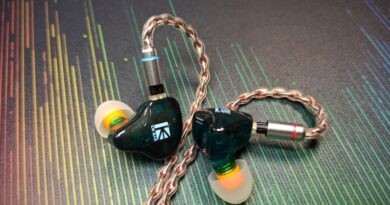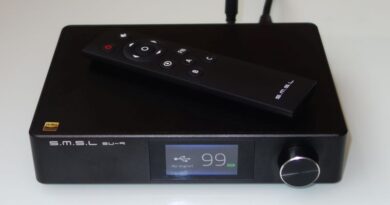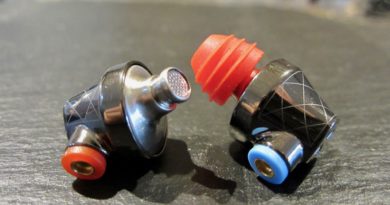HELM DB12 AAAMP Portable Headphone Amplifier Review – The Sky’s Your Limit
Pros — Powerful THX certified amplification with minimum distortion resulting in good sense of ease and enlarged headroom with my iPhone; extremely convenient for mobile use; brings anemic devices to life; more versatile than digital devices as it work with analog and digital sources; needs no software, driver, or app; lightweight device; carrying bag is roomy.
Cons — No automatic power off; bass boost at too low a frequency to be effective; fixed cables; sound relies to a large extent on source dac; non-serviceable battery (planned obsolescence).
In this Article
Executive Summary
The Helm DB12 is a powerful portable, battery-operated inline headphone amplifier that serves the sole purpose of adding 12 dB of linear gain to your audio signal (plus an optional independent 6 dB linear bass boost) in numerous applications.
Introduction
Helm Audio are a British-American company established in 2017. Their Helm DB12 amp was introduced at CES Las Vegas in 2020. At a time where integrated headphone dac/amps (“dongles”) flood the market, the Helm DB12 is a bit of an oddball device: old school connectivity paired with the latest THX amplification technology.
Helm are cooperating on the DB12 with THX, a company established by George Lucas in 1983 to make his Star Wars movies sound better. THX is currently owned by Razer, a Hong Kong manufacturer focusing on devices for gamers,
The rather light Helm DB12 lamp looks a bit rudimentary with its oversized buttons and it is similar in size and shape to a Bounty chocolate bar. Audio enthusiasts slaved to their desktop stacks may roll their eyes….but never judge a book by its cover. Bottom line: it works, and it does so very well.
The Helm DB12 is marketed primarily as a mobile device, to be used with your phone or tablet. And this this works very well, there are so many other uses one could think of. Stay tuned.
Specifications
| Highlights: |
| 12 dB volume gain, 6 dB bass boost |
| No software or app needed |
| THX-certified |
| ~6-hour battery life |
| USB-C charging |
| Female 3.5mm-male 3.5mm plug |
| Product Page: Helm Audio |
- HELM Audio
- THX Certified
- Amplifier: THX’s AAA™ amplifier
- Material: Aluminum
- Input: Stereo TRRS 3.5 mm male connector
- Output: Stereo TRRS 3.5 mm female connector
- Frequency response: +0.01 / -0.2 dB 20 Hz – 20 kHz with 32 Ω load
- Output impedance: <0.4 Ω
- Output power: 109 mW at 16 Ω with <0.1% THD (watts per channel,) 111 mW at 32 Ω with <0.1% THD (watts per channel)
- THD: -102 dB, 16 Ω, 10 mW: 0.0008%
- THD: -102 dB, 32 Ω, 5 mW: 0.0008%
- THD: -109 dB, 10 Ω, 0.049 mW: 0.00035%
- IMD: -70 dB, SMPTE 70 Hz + 70 kHz, 16 Ω: 0.03%
- IMD: -80 dB, SMPTE 70 Hz + 70 kHz, 32 Ω: 0.01%
- IMD: -80 dB, SMPTE 70 Hz + 70 kHz, 10K Ω: 0.01%
- Crosstalk: – 91 dB, 10K ohms: 0.0028184 %
- Noise (A-wt): 10 uV, potentiometer at nil
- SNR: 114 dB, 300 Ω, <1% THD
- Gain: +12 dB (full range), +12 dB and +6 dB on 60–100 Hz frequencies (Bass Boost)
- Power supply: Internal USB rechargeable battery
- Battery life: 6+ hours in use
- Weight: 1.08 oz (30.55 g)
Physical Things


In the box are the amplifier unit with fixed cables, a USB-C charge cable, a roomy carrying bag, and the usual paperwork. The body is made of brushed aluminium, the inline-remote buttons and the on-off-bass slider are made of plastic. The unit is rather light and sits well in my hand. The large buttons make operation easy.
Functionality and Operation
What It does
- connects to the 3.5 mm audio socket of your phone/tablet or computer…actually of any device. Also works with OTG/Apple lightning adapter
- 3.5 mm sockets include airplane entertainment system, car stereo, gaming consols, dap, iPod, discman, walkman, radio…
- is purely analog: operates independently on software and drivers…picks up any signal and adds a linear gain of 12 dB and, if desired, and independent 6 dB of bass boost
- works plug’n’play, no drivers needed
- allows for phone signal to pass through its TRRS connectors and adds volume to your phone calls
- conserves phone battery
- saves iPhone users from buying the pricey Apple camera adapter
- creates space on the go: no bulky device strapped onto the phone with rubber bands
- has no dropouts as with dongles (when moving around in one’s pocket)
What It does not
- no digital to analog signal conversion
- cannot be connected to a USB port
The Helm DB12 is essentially a self-powered headphone cable extension that amplifies and upgrades your source device. You could also say it is an oversized inline remote with integrated amp that reminds me of the control panel of my wife’s heating blanket. And it works like a regular inline remote that is part of many Sennheiser and AKG headphone/earphone cables.
When the Helm DB12 is switched off or out of battery, your headphone and source device still work as it it was not connected at all, thanks to the TRRS connector. This is very useful for A/B-ing. TRRS also comes in handy for phone calls, which do not work with USB dongles.
https://en.wikipedia.org/wiki/THX
The Helm DB12 has two main purposes: to amplify your source’s analog signal and to make it sound better. As a side effect, it preserves/conserves your phone’s battery.
The Helm DB12 has an on/off switch that, if moved one step further, activates a bass boost. Of the large three buttons on top of the device (ergonomically useful as easily usable inside your pocket), the middle one is start/stop/forth/back and the two outer ones are volume up/down (just like the Apple remotes). When increasing/decreasing volume with these buttons, the slider on my iPhone moves up/down accordingly.
And that’s it. Or not. The Helm DB12 is meant to be connected to your phone/table or computer via their 3.5 mm socket – the simplest plug-n-ply possible. iPhone users will save their money on the Apple camera adapter.
But that’s still not where it stops. The fact that there is no dac, the Helm DB12 has distinct advantages: you can connect it to essentially any device with a 3.5 mm headphone jack, be it an iPod Classic, a walkman/discman, even a normal FM radio or a car stereo, or an airline entertainment system. The options are unlimited to combine the latest THX amplification technology even with your vintage devices – anything with a 3.5 mm socket.
You can also use the Helm DB12 in combination with in-line with portable headphone amps like the Helm Bolt. A/B-ing is easy: just switch the Helm DB12 on and off.

The remote buttons only worked properly when connected directly to my iPhone’s 3.5 mm socket of the Apple Audio Adapter. When putting a portable dac/amp between phone and Helm DB12, the volume will have to be controlled from the phone. The DB12 amp still adds a constant 12 dB linear gain.
When connected to my Mac’s headphone jack, the 3-button remote is not fully functional. Both middle and “+” button only work for start/stop/forward/back functions. The “-” is disabled.

Practical mobile Use
The Helm DB12 is marketed as a mobile headphone amplifier so I primarily tested it with my phone on the road. The device essentially works as a three-button remote on steroids. It is practically more and add-on to the headphone than to the source device. It is like lowering the output impedance and increasing the sensitivity of power-hungry headphones.
Whenever you plug the Helm DB12 in, it works – no software needed. The large buttons are extremely handy for adjusting volume and and forwarding tracks in my pocket. No need to fiddle with the phone’s screen and no need to strap a portable amp onto it with rubber rings…which has been awkward at best of times.
Operating the volume buttons moves the iPhone’s volume slider up and down, too. The Helm DB12 essentially just adds a constant power of 12 dB and relegates the iPhone’s amp to pre-amp, in analogy to a power amplifier in your home stereo.
I could add a dongle such as the Helm Bolt between phone and Helm DB12 to use as dac/pre-amp, but this would block the phone’s signal. This combination drives power-hungry full-sized earphones of 300-600 Ω impedance well.
But while this scenario is rather unrealistic in mobile use, it is good practice when working with computers to improve on their built-in poor-quality dacs. To give you an idea of the unlimited use of the Helm DB12, please watch my video.
Amplification
The Helm DB12 received its name from the 12 dB of linear volume again it adds to any audio signal. This is rather strong considering that perceived volume doubles every 10 dB, if I have not snoozed in physics completely.
Independently, a 6 dB bass boos can be added, too. THX Achromatic Audio Amplifier technology stands for almost zero distortion.
Battery Life
The Helm DB12 contains a non-serviceable lithium-ion battery with a 6-8 hrs of battery life. This is beneficial on the road as it conserves battery life of the device “phone” it is connected to.
And if the battery runs empty, the Helm DB12 just acts as cable extension without any adverse effect on the operation. It can be fast-charged in 2.5 hrs via USB-C with any 5V charger.
Unfortunately, the Helm DB12 will have to be disposed of once the battery has been consumed.
Sound
The sound obviously depends on the source dac and the DB12 combined. It therefore varies across devices it is connected to. But the intended use is with a phone (or similar) – and I tested the Helm with my iPhone SE (1st generation), connected weather via the Apple Audio Adapter or directly plugged into the headphone jack – made no sonic difference.
I used it with some 60-70 Ω headphones such as the Koss HPH30i, Koss Porta Pro and Sennheiser HD 25, all mid-sized headphones that are realistically used on the road in real life, and that are exceeding the 50 Ω recommended max. impedance manageable by phones.
The Helm DB12 adds life to the comparatively brittle Apple-only sound – and a lot of it. Everything becomes wider, bigger, swifter, air and a sense of ease are added, soundstage and headroom are greatly enlarged, space is added between instruments, and the sound becomes clearer and sparklier.
It is as if you transferred your live concert from a smokey bar into a big stadium (around your head). Sound is/remains natural, not analytical or sterile.
This effect also works with <50 Ω earphones (average impedance is 32 Ω), so the Helm adds to the sound even when its strong power is not needed upon, just by downgrading the Apple’s amp to a pre-amp.
But this “stretching” and added “fluffiness” of the musical image also means sacrificing some heft/punch, density/note weight, depth, and intimacy. The amplification is essentially distortion free, hiss-free, and it is linear. There is no bass boost or metallic upper edge, the whole experience is rather smooth.
The situation is different when plugging the Helm DB12 into my MacBook Air with its limited-quality built-in dac. According to the motto “garbage in, garbage out”, the DB12 simply amplifies the Mac’s dull sound – and therefore needs the support of a dongle’s better-quality dac in series with the DB12.
Helm offer the Bolt portable dac-amp (which I don’t have) so I mainly used the AudioQuest DragonFly Red to take over the signal decoding from my MacBook. This worked well even with full-sized headphones used preferably at home such as the 300 Ω Sennheiser HD 600. And since essentially any dongle above $80 drives a 300 Ω headphone, the Helm brings this up to 600 Ω.
The basic sound signature could be varied using different dongles (e.g. EarMen Sparrow or Eagle, Shanling UA2, Earstudio HUD 100, AudioQuest DragonFly Cobalt, AudioQuest DragonFly Red) but the principal underlying effects as described with the iPhone remained.
A word on the bass boost: switching it on adds an independent 6 dB bass gain. This did not do it for me as the gain is at a frequency too low to add an effective punch to the low end for my taste. No comparison to the zippy Xbass in the ifi Audio hip-dac.
Concluding Remarks
The Helm DB12 is a versatile amp for on the road improving the sound of my phone, particularly with less sensitive headphones and iems, while being easy to operate in my pocket.
At home, it upgrades the dongles on my computer for driving particularly power-hungry headphones up to 600 Ω. But as the Helm DB12 amplifies any device with a 3.5 mm headphone socket, its applicability knows no limits.
Until next time…keep on listening!

Disclaimer
The Helm DB12 war provided by Helm Audio for my review – and I thank them for that. You find the product page here.
Our generic standard disclaimer.
You find an INDEX of our most relevant technical articles HERE.





Gallery








